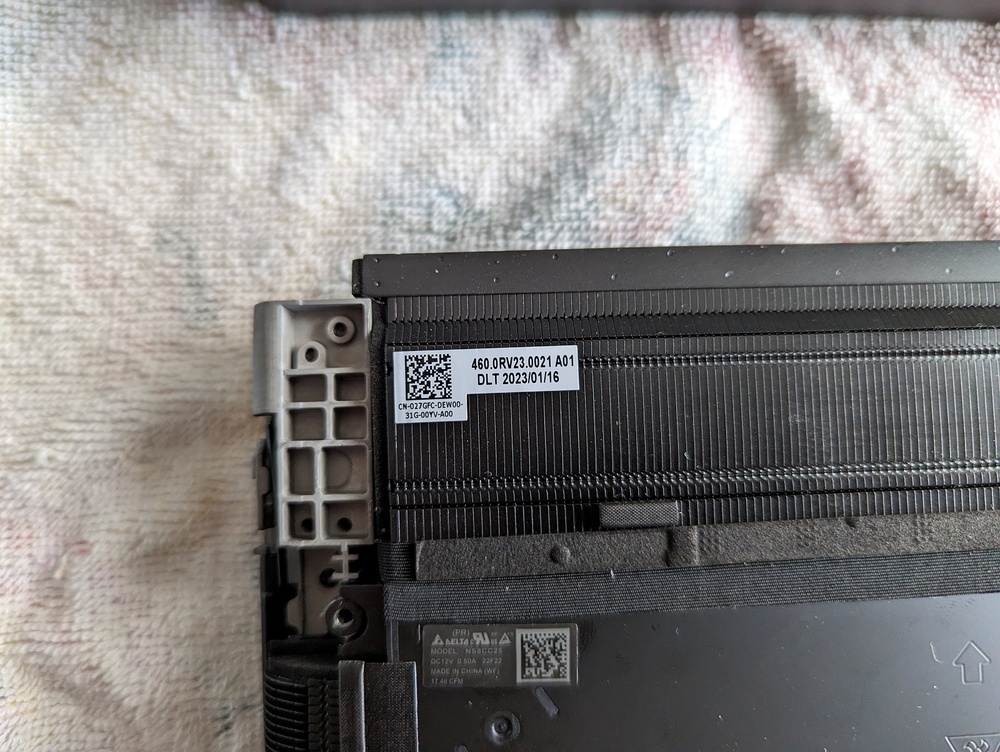
win32asmguy
Member-
Posts
652 -
Joined
-
Last visited
-
Days Won
3
Content Type
Profiles
Forums
Events
Everything posted by win32asmguy
-
Any M18 R1 AMD owner that could help me?
win32asmguy replied to jimmypops's topic in Alienware 18 and M18x
I tested cold / hot booting Fedora 38 (kernel 6.3.8, nvidia 530.41.03, xorg, bios 1.8.1) with battery power under 60%, no issues. I did have to set nvidia-drm.modeset=1 to get rid of a phantom display but that issue occurred regardless of being on battery or plugged in. I do have secure boot disabled and no battery charge limiter set. I have had a similar issue with the Precision 7740 in the past (would not boot linux on battery). The issue was a bad Intel CPU microcode update bundled with Ubuntu at the time which had to be disabled via a kernel flag. -
Any M18 R1 AMD owner that could help me?
win32asmguy replied to jimmypops's topic in Alienware 18 and M18x
I can test fedora 38 tonight, but mine is the Intel model. I will let you know if I can replicate it. I take it you have also installed to an SSD but it still cannot boot on battery under 60%? -
I am thinking about trying to mod the bottom panel of my M18 to remove the stock honeycomb slats over the fans, so it removes the high pitched fan whistle. If I run the system with the bottom panel off, there is no whistle at any RPM. I also tried switching heatsinks so I think it is not the brand of fan causing the issue. I can pretty easily order a replacement panel spare part from Dell if I mess it up. The hard part is finding some replacement mesh to use instead. Any good sources for something like that? Most of the metal mesh for car related mods (custom grills, etc) seems to be 20GA or more which is too thick for this application I think. I also thought I might be able to find an old used bottom panel from ebay and use its mesh as a donor.
-
Interesting results. I did not expect my 12900K to be that far behind yours, or maybe even ahead at 4.2Ghz all core. I had tested with LLC at 1.1 but in order to get 21,500 it had to be on a cold boot with ambients at 65F or lower. I heard that 14th Gen is coming to LGA1700. Shame that we cannot have compatibility with that via a bios update here. Missed opportunity. Every day I talk to tuners working with these new BGA-only models and it really isn't comparable to what we used to be able to do with modular CPUs.
-
Alienware M18 undervolt protection won't disable
win32asmguy replied to MogRules's topic in Alienware 18 and M18x
Sadly dynamic undervolting is still disabled by default in the new bios version, so you would still have to manually set that flag via UEFI setup variables. This bios does have a build date of 5/29/23 but maybe they did not have enough time to integrate that change and validate it. However now I can train and boot 6400 CL38 1.35V via selection of XMP profile 1. It also appears to disable SAGV with XMP active now. Before on 1.7.0, any type of memory change would end up with SAGV re-enabled which could have been why it could not train and boot. There was a similar issue on the Legion 7 Pro that the community discovered earlier.- 60 replies
-
Alienware M18 undervolt protection won't disable
win32asmguy replied to MogRules's topic in Alienware 18 and M18x
A new bios was released this morning, 1.8.1. Related to XMP memory support according to the notes, but maybe undervolting protection is disabled now too. Time for me to test the Kingston 6400 CL38 1.35v memory again to see if they can boot.- 60 replies
-
- 1
-

-
Dissapointing about the performance, but not surprising. The only advantages I see from this new model compared to competitors is three 2280 M.2 drive slots, easy to replace keyboard, non gamer accented chassis, and if system76 gets their open firmware and ec working it could be more tunable with some work.
-
Yeah, it was like this from the factory. The previous m18 I had last month also had Delta fans and the same noise. I would like to try a version with the Sunon fans but the challege is getting the part number and ordering it because the reps do not usually give out this information or allow selection of a specific brand when getting a warranty replacement. Usually spare parts sales reps will sell you the part if you already know the number. Attached is a picture of the Delta version heatsink. The part number sticker is located under the rear IO cover.
-
Does anyone here happen to have an m18 R1 with 4080+ and the Sunon or FCN fan heatsink? I am troubleshooting some fan whistle (any RPM, louder as RPM increases). Mine has the Delta fans, part number 27GFC for the whole unit. Also its possibly an interaction between the bottom panel venting cuts as the whistle is not present with the bottom panel removed.
-
@iieeann I would suggest resetting to factory defaults in the current bios and then trying again. If it still does not work maybe try removing bottom panel, disconnecting the battery and then holding the power button for 30 seconds (they call it draining residual flea power). Dell does have this "force a bios update" process, but ideally the normal process would work first: https://www.dell.com/support/kbdoc/en-us/000134938/forcing-a-bios-update-without-the-ac-adapter-attached-on-a-dell-laptop
-
I tested both stock Windows 11 Pro OEM install (by Dell) and also a clean install Windows 10 Pro which basically test the same for GPU score. For CPU score Windows 10 Pro is indeed superior. Do you have VBS/HVCI disabled in Windows 11, and Turbo Boost 3.0 disabled (allowing GPU Dynamic Boost) in the bios, and GPU Memory ECC disabled? Those could potentially effect performance. You would probably want to run the test while recording GPU Power used, to ensure its using 135-140W under load. There is a small variance in silicon quality but I would suspect that at the same TGP and temperature an RTX 5000 Ada should always be higher performance than a RTX 4000 Ada. I will say that I would not be surprised if there is a Dynamic Boost bug as those have existed in the past models, 7770 for instance with 3080Ti could not go beyond 130W without overriding power limts using certain drivers, despite being advertised as "150W TGP" in Nvidia Control Panel.
-
Ok, I think power is limited somewhat in balanced / optimized, so you might want to try "Ultra Performance" and see if it improves. I would expect your system to get around 17k in Timespy Graphics at around 135-140W. Also if possible you could contact 3dmark support and ask them to whitelist the RTX 5000 Ada GPU as it is new and hidden by default. You can check if they fixed it by opening the link you posted in an incognito window.
-
It has been a few days and so far it seems like CBR23 Multi has gone up slightly (best seen was 29,900) and CBR23 Single can now sustain 5.5ghz, scoring 2150. Also Timespy Graphics scores 16,600 which is up a bit as well. I also got the bios dumped, and tried to do some undervolting which was not successful. The "undervolt protection" remains enabled regardless of the value set to the hidden UEFI variable similar to the experience reported on the XPS 17. Setting voltage offsets for P-cores also did not have any effect. I also tried modifying AC/DC LL to both 1.35 which did not boost scores any.
-
Dell is pushing CAMM, a priorietary RAM module format
win32asmguy replied to Etern4l's topic in Components & Upgrades
The other 4 SODIMM systems all perform a bit worse if you are only using two SODIMMs. Basically they operate at 4000MT/s regardless of what faster speeds are supported, with the exception of the GT77 where with the advanced bios you can override the behavior (but also greatly increase boot time). With the Precision 7780 and the CAMM to SODIMM interposer it can boot 64GB Kingston Fury at DDR5-5200 CL38. The same motherboard can also take a 128GB CAMM module if capacity is needed over speed. Of course, it is probably a moot point in terms of performance uplift because this system is also limited by its small cooler, lack of undervolting support, low GPU TGP, 240W power brick, and lack of fan speed control. -
Yeah more CTO options would be nice if they have the chip supply to do it. I could see them adding 13980HX or 7945HX with 4080 in the future. As far as pricing I wish I could pay them more to send the GAN 330W power supply, and also to not apply Element 31 to the high end CPU and GPU options. They should also add some bios options to disable the rainbow RGB bootup effect, disable the rear light ring, and set the keyboard to white-lighting only.
-
Thanks! So it sounds like these high end GPUs are probably thermally limited by the cooling system. Mine did get consistently better after a repaste (probably if anything because the CPU wasn't throttling as bad at reasonable combined load limits). Does yours also report "145W Maximum Graphics Power" in Nvidia Control Panel System Information? Yes, on a flat surface it was reaching the 87C GPU throttling limit with ~140W GPU and ~30W CPU combined load. However if I put the system on a laptop stand it does drop down to high 70's. The die size for AD103 is decently larger than AD104 so I thought maybe the same wattage over a larger surface area would be more efficient.
-
Yeah it has only had a single LED for a few generations now just showing battery charge status and diagnostic codes if there is a boot issue. Out of curiousity are you able to run a Timespy benchmark on the RTX 5000 Ada mobile chip? Curious where it ends up compared to the RTX 4000 Ada which gets about 16,600 in Timespy Graphics drawing up to 140W. I have heard the larger die is easier to cool so it may be better suited to the cooling solution.
-
Yeah after looking into what causes this, it apparently is the Intel "Innovation Platform Framework" which is just a new name for DPTF. Throttlestop can disable its effects or the drivers can be blocked from installation. So it can go higher with that disabled but it still runs into thermal throttling. PTM7950 repaste is the next step. An aftermarket heatsink is an interesting idea, but I am not sure how they could improve on it. Vapor chamber? Additional heatpipes? A thicker bottom panel to allow for higher CFM fans and larger fin stacks?

